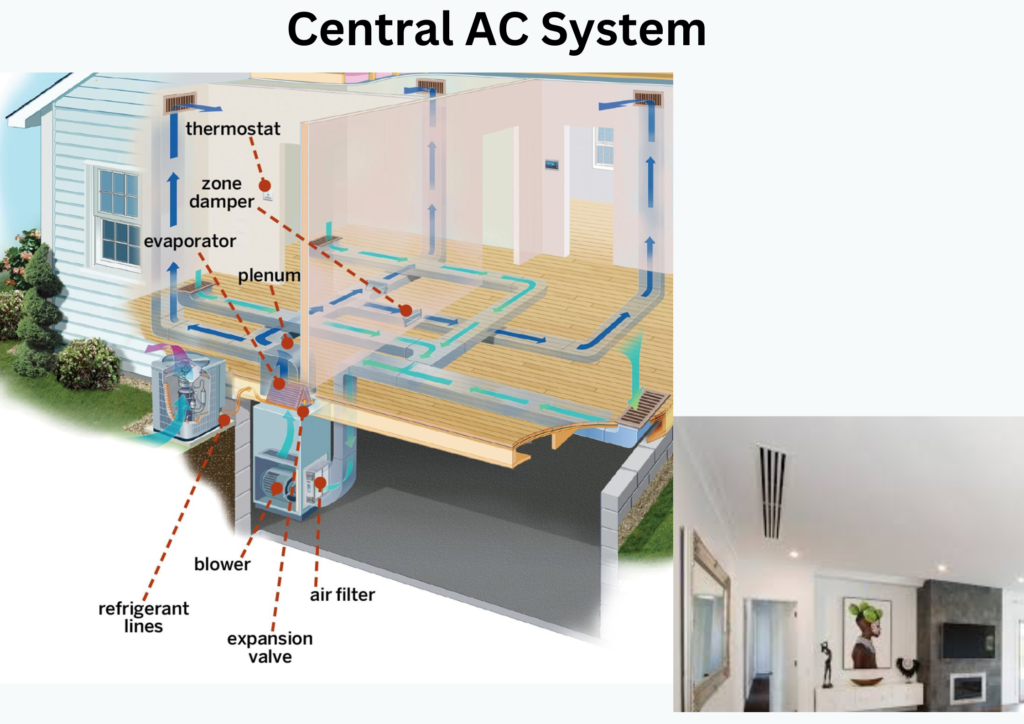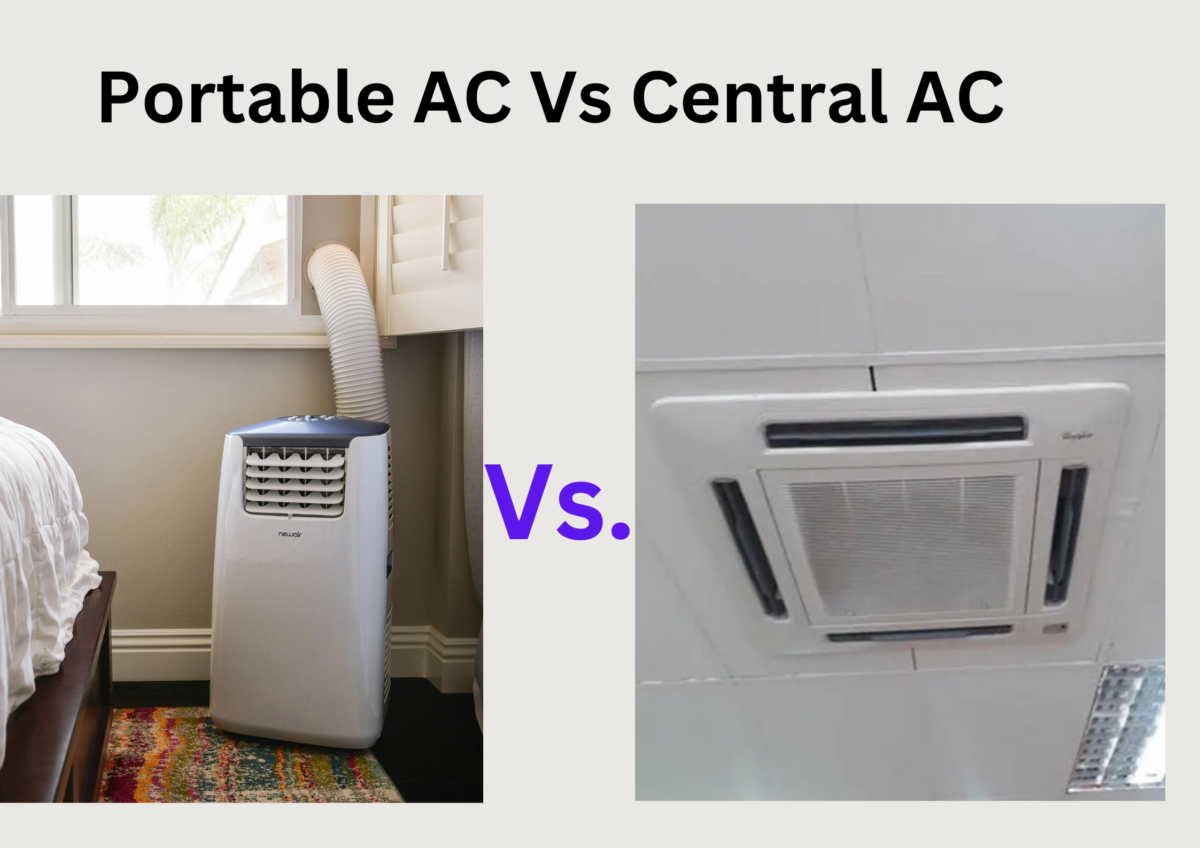Are you thinking of installing an air conditioning system in your new home? Are you getting confused between the two popular types of air conditioning systems i.e. portable AC and central AC?
This article explains in detail about “portable AC vs central AC”. The definitions, working principles, pros, cons, energy efficiency, maintenance, and cost of both the portable AC and central AC systems are described below.
Read the full article and select the best product for your home.
Definition (Portable AC vs central AC)
What Is a Portable AC System?
A portable air conditioner (AC) system is a self-contained portable system that provides cool air for optimal comfort during hot summer days. This device is equipped with wheels or casters to transfer from one room to another easily.
Portable ACs are easy to install and are provided with an installation kit. This device should be attached to an open window and placed 5 to 7 feet away from the wall for proper functioning. After placing the device inside a room or, to a nearby window you can enjoy the cool and refreshing air.
There are mainly 2 types of portable AC system
- Single Hose Portable Air Conditioner
- Dual Hose Portable Air Conditioner

| Midea 12,000 BTU Air Conditioner | BUY NOW |
| BLACK+DECKER Air Conditioner | BUY NOW |
| Dreo Portable Air Conditioner | BUY NOW |
What Is a Central AC System?
A central AC system is a whole home air conditioning system where the air is cooled at a central location and circulated throughout the home by one or more fans or ductwork. This type of system refers to a whole home cooling solution that is perfect for large spaces.
A central AC system passes the warm indoor air through the cold coils and then it circulates the cool air throughout the entire home. The main component in this process is the compressor in which compression of the refrigerant gas takes place and thus the heat is expelled out of the house.

Components (Portable AC vs central AC)
What Are the Components of a Portable AC System?
The important components of a portable AC system are
- Compressor: It absorbs the heat from the room and ejects it out of the house through a flexible tube.
- Condenser coil: It is used for cooling down the hot refrigerant.
- Evaporator coil: This is responsible for cooling the air.
- Fan: It draws in the hot and humid air from the room.
What Are the Components of a Central AC System?
The four main components of a central AC system are
- Evaporator coil: This is placed inside the house. The refrigerant gas inside the coil absorbs heat from the indoor air and turns into a gas.
- Condenser coil: This is placed outside the house. Here the refrigerant releases heat and again turns into liquid.
- Compressor: The compressor compresses the refrigerant and converts it into high-temperature high-pressure gas.
- Expansion Valve: It removes pressure from the liquid refrigerant.
Working Principle (Portable AC vs central AC)
How Does a Portable AC System Work?
The working principle of a portable air conditioner is described below.
- The fan draws the air from the room into the portable AC system. The whole system is contained in a single unit and is placed inside the room.
- This system contains refrigerant which is used as a heat exchange medium. When the hot indoor air comes in contact with the refrigerant inside the evaporator coil, the cooled refrigerant absorbs the heat from the air. The cooled air is then circulated back into the room.
- After absorbing the heat, the liquid refrigerant converts into gas. The compressor compresses this gas into high-pressure high-temperature gas and sends it to the condenser coil.
- Inside the condenser coil, the condensation process occurs and the high-temperature gas converts into liquid form and the process continues.
- When the refrigerant is compressed heat is produced which needs to be exhausted. For this, the portable AC system contains an exhaust nose which is utilized to vent the heat out from the room.
- This is a continuous process where the system draws in the indoor air, passes it over cold coils, cools it, extracts its humidity, and emits the heat through the vents at the back of the machine.
How Does a Central AC System Work?
- The fan inside the system draws in the indoor air and passes it over the evaporator coils.
- The refrigerant inside the evaporator coil absorbs the heat from the air and turns into gas. The cooled air is then circulated back inside the room.
- The refrigerant gas then moves into the compressor where the compressor compresses it into high-pressure high-temperature gas and sends it to the condenser coil.
- The condenser coil is placed outside the house. It releases the heat carried by the refrigerant into the outdoor air and converts the refrigerant into liquid form.
- The liquid refrigerant is again sent back to the evaporator coil and the process continues to maintain temperature inside the house.
Pros and Cons (Portable AC vs central AC)
Pros and Cons of Portable AC System
Pros
- Easy Installation: The installation of a portable air conditioner is easy. You can do it by yourself without taking help from a professional.
- Movable: This portable system is a lightweight device. It can be easily transferred from one room to another with the wheels attached to it.
- Suitable for Small Rooms: This device is best suitable for a small room.
- Affordable: These devices have a low upfront cost.
Cons
- Noisy: As the whole system is a single unit and is placed inside the room, it produces noise during its operation.
- Less energy efficient: This system takes more time to cool down a room so, these are less energy efficient than other types of AC systems.
- Drainage Problem: Some portable ACs contain a water tank, which needs to be drained out regularly.
Pros and Cons of Central AC System
Pros
- Offers Consistent Temperature: A central AC system is perfect for homes in areas where Summer is almost too hot. It offers consistent temperature all year round.
- Improves Indoor Air Quality: The central AC system is integrated with advanced filtration technology. It filters out airborne particles, harmful gases, bacteria, etc. from the air and circulates the clean, fresh, and conditioned air throughout the home.
- Programmable Thermostat: This feature allows the user to regulate the temperature according to their requirement. This also increases the energy efficiency of the device.
- Produces Less Noise: As most of the parts of a central CA system are placed outside the home, the users will not be disturbed by any kind of noise produced by the device.
- It improves the appearance of the home.
Cons
- High Electricity Bills: As the system cools the entire home, it needs to consume more energy and it significantly raises the electricity bills.
- High Maintenance Cost: For proper functioning, this system needs to be maintained regularly which is costlier.
- Need for Ductwork: If your home does not contain any ductwork, then it needs major renovation including opening up floors and walls to install a central AC system.
Energy Efficiency (Portable AC vs central AC)
Systems with higher energy efficiency ratings are more energy efficient. They consume less energy and produce less electricity bills. These systems are durable and last longer. However, the upfront cost of an energy-efficient system is higher but in the long run, they save a lot of energy bills.
Energy Efficiency of Portable AC System
CEER (Combined Energy Efficiency Ratio) rating is the new standard to measure the energy efficiency of a portable AC system. The higher the CEER rating value, the more energy efficient the system is. The CEER rating of a portable AC system falls between 6 to 10.
Whereas the EER (Energy Efficiency Ratio) rating of a portable AC system ranges between 8 and 12.
Energy Efficiency of Central AC System
The energy efficiency ratings of a central AC system are slightly different which is known as SEER2 (Seasonal Energy Efficiency Ratio) ratings. The SEER2 rating value of a central AC system ranges between 13 to 21.
Moreover, portable AC systems are less energy efficient than central AC systems.
Cost (Portable AC vs central AC)
Cost of Portable AC System
Depending on the type and cooling capacity (British Load Units or, BTUs) the cost of a portable AC system varies. Usually, its price range varies between $250 to $1800. The most common sizes of portable AC systems are 6000 BTUs to 18000 BTUs.
Cost of Central AC System
A 1.5-ton central AC unit costs approximately $3000. The average cost of a central AC system varies between $3000 to $6000.
Maintenance (Portable AC vs central AC)
Maintenance of Portable AC System
The maintenance of a portable AC system is not very complicated. You don’t need to get help from any professionals, and you can do it yourself.
In portable AC systems, the air filters should be cleaned or replaced at regular intervals as suggested by the manufacturers. While removing moisture from the air, the water drops fall into the collection tray. The system must be emptied frequently if it contains a water bucket or collection tray to collect water drops.
Maintenance of Central AC System
For proper functioning and to improve efficiency, the central AC system needs regular maintenance. You need professionals for proper maintenance of a central AC system. The maintenance of a central AC system includes
- The air filters of the system must be cleaned frequently to improve the indoor air quality.
- The condensate drain must be cleaned regularly.
- The dust on the fan barrel and coil placed inside the indoor unit must be cleaned properly.
Environmental Effect (Portable AC vs central AC)
Environmental Effect of Portable AC System
The portable AC system releases less amount of harmful gases into the outdoor air and is comparatively less harmful to the environment as it
Environmental Effect of Central AC System
The central AC system uses electricity to produce cool air and creates a comfortable indoor environment. Electricity production in tuns depends on fossil fuels.
Central air conditioners use chlorofluorocarbons (CFCs) and bromofluorocarbons (BFCs) to produce cool air. When the system releases these harmful ozone-depleting pollutants into the environment, it affects the ozone layer and creates global warming.
Conclusion
A portable AC is used to cool a single room whereas a central AC provides cool air to a large space. A portable AC system consumes more power to cool down a room and thus the system is less energy efficient. A central AC system with advanced features is more energy efficient and in the long run, it saves energy bills.
So, if you have budget and space constraints, then a portable AC is a suitable option for you. However, if you are searching for a system to cool down your massive home and also looking for an energy-efficient option then central AC is the best option for you.
FAQS
- Does central air or portable AC use more electricity?
The portable AC uses more electricity than a central AC. Thus, the central ACs are more energy efficient than the portable ACs.
2. Is central AC better than portable AC?
Yes, central AC is a better option than a portable AC unit. Central ACs are more energy efficient and can cool a large space with multiple zones. Whereas, portable AC consumes more power and can cool down a single room at a time.
Also Read
- Is Central AC Good for Home?
- Why Are HVAC Systems So Expensive? 10 Most Common Reasons
- What Size of HVAC System Do I Need? 2024
- What Is the Most Efficient HVAC System and Why? 2024
- Types of HVAC Systems in Apartments 2024
- HVAC System Working Principle
- HVAC System Vs Air Conditioning System: 6 Major Differences
- What Are the Most Common Types of HVAC Systems? 2024
- 6 Types of HVAC Systems for Homes 2024
- How Does a Refrigerator Work? A Step-by-Step Guide 2024
- 8 Reasons Why Refrigerator Not Cooling and Solutions
- Side By Side Vs French Door Refrigerator 2024
- Counter Depth Refrigerator vs. Standard Refrigerator: Which One Is Better?
- Where Should I Place My Air Purifier? 2024
- How Do You Know If You Need an Air Purifier? 2024
- HEPA Air Purifier: Definition, Types, Uses, Efficiency, Working Principle
- Whole House Air Purifier: Types, Pros, Cons, Working Principle 2024
- Air Purifier Advantages and Disadvantages
- How Do Air Purifiers Help? 6 Benefits
- Whole House Dehumidifier: Types, Working Principle, Pros, Cons 2024
- How Does a Commercial Dehumidifier Work? 2024
- How Does a Dehumidifier Work? Types, Uses, Benefits 2024
- 10 Tips for Buying a Dehumidifier
- Dehumidifier Vs Air Purifier 2024
- Dehumidifier vs. Air Conditioner 2024


7 thoughts on “Portable AC Vs Central AC: Which One Is Right for You? 2025”